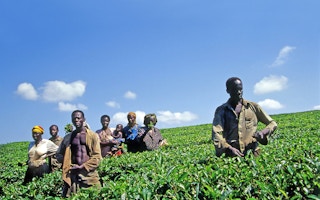In Africa, where some 280 million people are already malnourished, any further difficulty in accessing nutritious food will be a problem. Africa has more stunted children today than it did 20 years ago, and up to 82 per cent of child under-nutrition cases are not properly treated, according to a recent United Nations Economic Commission for Africa (UNECA) report.
To continue reading, subscribe to Eco‑Business.
There's something for everyone. We offer a range of subscription plans.
- Access our stories and receive our Insights Weekly newsletter with the free EB Member plan.
- Unlock unlimited access to our content and archive with EB Circle.
- Publish your content with EB Premium.
This poses a huge threat to the continent’s future. Africa stands to lose the equivalent of 2-17 per cent of GDP annually due to child hunger, according to UNECA. Access to enough nutritious food is, therefore, an imperative.
Unfortunately, simply growing more crops in Africa will become harder as a result of climate change. Even under mild scenarios, where the world warms by only 2 degrees Celsius, Africa already stands to endure substantial losses.
Not only will Africa experience a growing population and a decline in food productivity, but a new study by Harvard University asserts that food will become less nutritious in a warming climate. Globally, dietary deficiencies of zinc and iron cause the loss of about 63 million life years annually. In Africa, around a quarter of the population already lives with a zinc and/or iron deficiency.
The Harvard study asked “will higher CO2 levels make crops less nutritious?” The researchers found that zinc and iron nutrient rates declined under higher carbon dioxide levels, although they were unable to pinpoint the mechanism responsible.
The study found that wheat had 9.3 per cent less zinc and 5.1 per cent less iron content. Higher CO2 also meant lower protein content in wheat (a 6.3 per cent decrease) and a 7.8 per cent decrease in rice grains, with a small but detectable impact on protein in peas. This suggests the path to Africa’s food security is blocked by a two-headed beast: tougher growing conditions for crops and declining nutrition from what is grown.
Hidden hunger
Iron is needed in all tissues of the body for basic cellular functions, and is critically important in muscle, brain and red blood cells. The WHO estimates that about one tenth of maternal mortality is attributable to iron deficiency in developing countries.
Similarly, zinc supports development during pregnancy, childhood and adolescence. Zinc deficiency can contribute to stunting, loss of appetite and impaired immune function. In Africa, zinc deficiency is responsible for around 20 per cent of lower respiratory tract infections, 10 to 22 per cent of malaria and 11 to 13 per cent of diarrheal disease.
According to the FAO, 22 countries receive 60 per cent of their dietary requirements of iron and zinc from grains and legumes. Six are in Africa: Algeria, Tunisia, Morocco, Libya, Egypt and Sierra Leone.
Reductions in zinc and iron content could lead to greater nutrient deficiencies across these populations - a phenomenon known as “hidden hunger” - and will increase the burden of disease associated with them. So this climate change impact is both a food security and health concern.
In response, Africa must strive to ensure its entire food system is resilient and robust enough to provide nutritious food to its citizens.
Many African countries have pursued industrialisation vigorously as part of their development plans over the decades. With industrialisation approaches promoting large-scale farming and geared towards more cash crops, there is a risk that cash crops like tea, coffee, tobacco and flowers will become more attractive to smallholder producers than staples, which could damage efforts to make Africa more food secure.
That points to an urgent need to address the interconnected factors that keep people from being food secure, including malnutrition, poverty and persistent social and economic inequalities.
Ecological Production
“
The good news is that ecological approaches to food security are, by their nature, designed to produce more under climate change. That’s one hit to the two-headed beast.
Fortunately, there are ways to grow more food under the changing climate. These require investing in our ecosystems (the foundation of agriculture) to make them more resilient to climate change, healthier and more productive.
There are nearly 70 million smallholder families in sub-Saharan Africa, and a myriad of ecosystem-based approaches to food security are readily available to help them.
Opportunities exist to produce more food without resorting to industrial agriculture. This process involves investing in the environment and reaping greater rewards through ecosystem-based adaptation for food security.
In Uganda, a project promoting agro-forestry and conservation agriculture resulted in more fertile soils and increased yields. This in turn reduced the time and cost spent preparing land for farming, enabling people to diversify into livestock rearing, for instance.
The project also resulted in lower use of agrochemicals and improved biodiversity, with 75,000 people benefiting. Some 31,000 tree seedlings have been planted to harness the ecosystem, and chili production encouraged, which earned poor households $60 per week during the off-peak season and $240 per week in peak season.
The ability to generate surplus incomes from agricultural practices has dramatically contributed to the food security of these households, while improving efficiency and encouraging better agroforestry practices.
In Zambia, a project introduced ecological agriculture, using water and nutrient recycling and other ecosystem services to increase soil fertility and crop diversity. Nearly two thirds of farmers reported surplus yields, with some yields rising as much as 60 per cent while surplus crop sales grew from 25.9 per cent to 69 per cent.
Similar farmer-led ecosystem rehabilitation techniques have taken place elsewhere on the continent. In Burkina Faso, farmers are using indigenous methods to rehabilitate land. By digging small pits (locally known as “zaï”) on barren plots and filling them with organic matter, some farmers are able to add nutrients to the soil while enhancing ground water storage to improve crop productivity.
These Burkinabe farmers have reclaimed 200,000 to 300,000 hectares of degraded lands, and have produced an estimated 80,000 to 120,000 additional tonnes of cereal.
Studies have shown that when we put in good natural inputs, we get out good natural inputs. A 2004 study confirmed that ecologically produced crops “contained significantly more vitamin C, iron, magnesium, and phosphorus and less nitrates than conventional crops”. Another 2001 study found that health-related defense compounds were seemingly more prevalent in ecologically grown produce over conventional crop produce.
More recent studies have shown a direct link between ecologically produced foods and human health. A 2011 study found that agro biodiversity (on-farm species diversity) could reduce the occurrence of anaemia.
Ecosystem-based adaptation also makes economic use of biodiversity. For example, some 100,000 species of insects, birds and mammals pollinate more than two-thirds of food produced around the world, according to the FAO.
While the benefits of ecosystem-based adaptation for food security are many, more research is needed to determine whether it can produce more nutritious food under the changing climate.
The good news is that ecological approaches to food security are, by their nature, designed to produce more under climate change. That’s one hit to the two-headed beast. In a world desperately seeking sustainability and more nutritious food for all, this could be agriculture’s best bet.
Richard Munang is UNEP’s Africa Regional Climate Change Co-ordinator. Jesica Andrews is the ecosystem adaptation officer with UNEP’s Regional Office for Africa. This story originally appeared on Thomson Reuters Foundation’s Alertnet.









